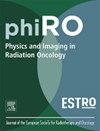基于Tversky集合的不确定性引导胰腺肿瘤自动分割
IF 3.3
Q2 ONCOLOGY
引用次数: 0
摘要
背景与目的胰腺总肿瘤体积(GTV)由于其形态的变化和不确定的基本事实而具有挑战性。以前基于深度学习的自动分割方法很难处理具有不确定基础事实的任务,并且不能适应风格自定义。我们的目标是通过利用不确定性估计技术,使用Tversky集成开发一个人在环胰腺GTV分割工具。材料和方法在本研究中,我们使用了282例来自医学分割十项全能胰腺任务的患者。随机选取30例患者作为独立测试集,其余252例患者分为80 - 20%的训练-验证组。我们在训练中引入Tversky损失层,训练出具有不同轮廓倾向的五元分割集合。Tversky集合通过估计像素级分割不确定性来预测概率图。在得到的概率图上使用概率阈值来生成最终等高线,从中提取11条等高线,并根据阈值的变化对地面事实进行定量评估。结果Tversky集合采用最优阈值配置,DSC为0.47,HD95为12.70 mm, MSD为3.24 mm。我们的性能优于swan - unetr配置,该配置在医疗细分十项全能的胰腺任务中取得了最先进的结果。结论我们的研究证明了采用基于集合的不确定性估计技术进行胰腺肿瘤分割的有效性。该方法为临床医生提供了一个共识概率图,可以根据他们的偏好进行微调,产生更有信心的轮廓。本文章由计算机程序翻译,如有差异,请以英文原文为准。
Uncertainty-guided pancreatic tumor auto-segmentation with Tversky ensemble
Background and purpose
Pancreatic gross tumor volume (GTV) delineation is challenging due to their variable morphology and uncertain ground truth. Previous deep learning-based auto-segmentation methods have struggled to handle tasks with uncertain ground truth and have not accommodated stylistic customizations. We aim to develop a human-in-the-loop pancreatic GTV segmentation tool using Tversky ensembles by leveraging uncertainty estimation techniques.
Material and methods
In this study, we utilized a total of 282 patients from the pancreas task of the Medical Segmentation Decathlon. Thirty patients were randomly selected to form an independent test set, while the remaining 252 patients were divided into an 80–20 % training-validation split. We incorporated Tversky loss layer during training to train a five-member segmentation ensemble with varying contouring tendencies. The Tversky ensemble predicted probability maps by estimating pixel-level segmentation uncertainties. Probability thresholding was employed on the resulting probability maps to generate the final contours, from which eleven contours were extracted for quantitative evaluation against ground truths, with variations in the threshold values.
Results
Our Tversky ensemble achieved DSC of 0.47, HD95 of 12.70 mm and MSD of 3.24 mm respectively using the optimal thresholding configuration. We outperformed the Swin-UNETR configuration that achieved the state-of-the-art result in the pancreas task of the medical segmentation decathlon.
Conclusions
Our study demonstrated the effectiveness of employing an ensemble-based uncertainty estimation technique for pancreatic tumor segmentation. The approach provided clinicians with a consensus probability map that could be fine-tuned in line with their preferences, generating contours with greater confidence.
求助全文
通过发布文献求助,成功后即可免费获取论文全文。
去求助
来源期刊

Physics and Imaging in Radiation Oncology
Physics and Astronomy-Radiation
CiteScore
5.30
自引率
18.90%
发文量
93
审稿时长
6 weeks
 求助内容:
求助内容: 应助结果提醒方式:
应助结果提醒方式:


